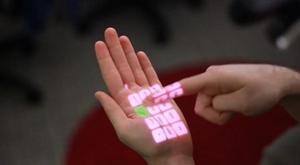GadgetsOmniTouch turns any surface into a touch screen
Researchers at Microsoft and Carnegie Mellon have created a shoulder-mounted device that can turn virtually any surface into an interactive touch screen; with OmniTouch users can now use walls or even the palm of their hands to control their smartphones

Omnitouch turns virtually any surface into a touchscreen // Source: internetsiao.com
Researchers at Microsoft and Carnegie Mellon have created a shoulder-mounted device that can turn virtually any surface into an interactive touch screen. With OmniTouch users can now use walls or even the palm of their hands to control their smartphones.
Chris Harrison, a postgraduate researcher with Carnegie Mellon’s Human-Computer Interaction Institute and the device’s co-inventor, explained that OmniTouch combines a miniature projector with an infrared depth camera, similar to the one used in Microsoft’ Kinect game console.
Using the camera to calculate depth information, the system is able to build a 3-D model of the environment that dynamically shifts with a user’s movements. That is to say, the size, shape, and position of the projected screen will match that of the improvised display surface.
OmniTouch “figures out what’s in front you and fits everything on to it,” Harrison said.
The system also actively monitors the environment for anything cylindrical and roughly finger-sized to determine when a user is interacting with the screen allowing them to scroll, swipe, press, and zoom like they normally would on a touch screen device.
For instance in one demonstration, OmniTouch was paired with an art application and used a nearby wall as a canvas and the palm of a user’s hand as the color palette.
“Using surfaces like this is not novel,” said Pranav Mistry, a researcher at MIT’s Media Labs who created a similar device two years ago called SixthSense. “The new thing is the accuracy and making it more robust.”
Duncan Brumby, a researcher at the University College London Interaction Center, echoed Mistry’s comments calling OmniTouch a fun and novel form of interaction.
“There’s a growing interest in this area of having ubiquitous, intangible displays embedded in the environment,” because the screen sizes of mobile devices can be limiting, Brumby explained.
OmniTouch is still in its early phases of development and Hrvoje Benko, one of the device’s researchers with Microsoft Research, admits that a shoulder-mounted camera is entirely impractical.
Benko was careful to note that “it’s not where you mount it that counts.”
“The core motivation was to push this idea of turning any available surface into an interactive surface,” he said.
Benko added that because the components used in OmniTouch are all off the shelf and constantly getting smaller, it is possible that the device could soon be “made into a pendant or attached to glasses.”
As for future applications for the device, Harrison said he is uncertain.
“It’s an enabling technology, just like touch screens. Touch screens themselves aren’t that exciting,” he said, it is how they are used.
So far the OmniTouch team has developed several applications including one that allows users to virtually annotate a physical document.
